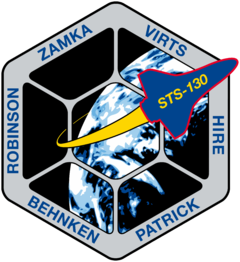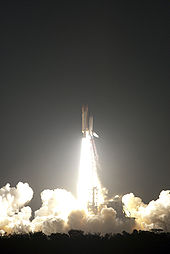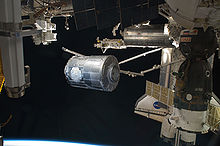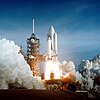STS-130
| Mission emblem | |||
|---|---|---|---|

|
|||
| Mission dates | |||
| Mission: | STS-130 | ||
| COSPAR-ID : | 2010-004A | ||
| Crew: | 6th | ||
| Begin: | February 8, 2010 at 09:14 UTC | ||
| Starting place: | Kennedy Space Center , LC-39A | ||
| Space station: | ISS | ||
| Coupling: | February 10, 2010 5:06 UTC | ||
| Decoupling: | February 20, 2010 0:54 UTC | ||
| Duration on the ISS: | 9 d, 19 h, 48 min | ||
| Number of EVA : | 3 | ||
| Landing: | February 22, 2010 at 03:22:10 UTC | ||
| Landing place: | Kennedy Space Center | ||
| Flight duration: | 13d 18h 6min 24 s | ||
| Earth orbits: | 217 | ||
| Track height: | 360 km | ||
| Covered track: | 9.2 million km | ||
| Payload: | Tranquility and Cupola | ||
| Team photo | |||
 v. l. No. Nicholas Patrick, Terry Virts, Robert Behnken, Kathryn Hire, George Zamka, Stephen Robinson |
|||
| ◄ Before / After ► | |||
|
|||
STS-130 ( English S pace T ransportation S ystem) is the mission name of a space flight of the US space shuttle Endeavor (OV-105) of NASA . It was the 130th space shuttle mission and the 24th flight of the Endeavor.
It took off on February 8, 2010 at 9:14 UTC , and landed on February 22 (February 21 local time).
STS-130 brought the Tranquility junction and the Cupola observation deck to the International Space Station . Cupola's most important tasks include controlling the station's robotic arm , communicating with astronauts during an exit, and observing Earth and space.
team
On December 5th, 2008 the team was named:
- George Zamka (2nd space flight), commander
- Terry Virts (1st space flight), pilot
- Robert Behnken (2nd space flight), mission specialist
- Kathryn Hire (2nd space flight), Mission Specialist
- Nicholas Patrick (2nd space flight), Mission Specialist
- Stephen Robinson (4th Spaceflight), Mission Specialist
Preparations
Upon completion of the STS-127 mission on July 31, 2009, the Endeavor was pulled into its maintenance hangar for routine inspections and repairs. At the end of October 2009, the MLP-2 mobile launch platform was driven into the Vehicle Assembly Building (VAB) and final assembly of the two solid fuel boosters began. About a month later, the external tank ET-134 was connected to the two boosters. On December 11th, the Endeavor was rollover into the VAB, where it was installed on the external tank in the following days. The transport (rollout) of the completed shuttle launch structure to the LC-39A launch pad took place on January 6, 2010. The integration of the payload into the orbiter was completed on January 20.
The six crew members participated in the Terminal Countdown Demonstration Test , a dress rehearsal of the launch at the Kennedy Space Center , from January 19-21 . The crew familiarized themselves with the equipment for the flight, the launch procedures and the safety precautions at the launch site. During the final readiness acceptance inspection on January 27th, the so-called Flight Readiness Review, the start date was officially set for February 7th. The team returned to Florida on the night of February 2nd and 3rd, and the countdown began one day later.
Mission history
Start, rendezvous and pairing
The first attempt at take-off on February 7 at 09:39:50 UTC was aborted shortly before leaving the T-9-minute interruption due to a band of cloud over the launch system. Due to its altitude and size, the cloud bank did not allow a return to the launch site in the event of a return to launch site (RTLS). A 24 hour shift was ordered.
On February 8, 2010 at 9:14:08 UTC, the Endeavor finally started its STS-130 mission without any problems. The visibility was very good that day, apart from a thin cloud cover. Observers in Cape Canaveral were able to see the light generated by the shuttle's rocket engines for around seven minutes with the naked eye. Two minutes after take-off, the two solid fuel boosters burned out as planned and were thrown off; after a total of just under eight and a half minutes, the main engines were switched off and the external tank disconnected. Half an hour later, the shuttle launched its first stable orbit with the help of its orbital engines . The crew then converted the shuttle for operation in orbit by opening the cargo bay doors, unfolding the Ku-band antenna and activating the robotic arm . The loading bay doors also serve as radiators , the Ku-band antenna is used for high-bandwidth communication, e.g. for live video.
The second day of flight (February 9th) served the usual inspection of the heat shield using the Orbiter Boom Sensor System as well as the preparation of the spacesuits and the coupling devices.
The Endeavor docked with the International Space Station on the third day of flight (February 10) at 5:06 UTC after the space shuttle had performed the mandatory rendezvous pitch maneuver . At 7:16 UTC the hatches between the two spacecraft were open and the crews greeted each other warmly. After a safety briefing by the ISS hosts, the united eleven-person crew carried out some logistical tasks. Mission specialist Nicholas Patrick and ISS flight engineer TJ Creamer took the OBSS attachment with the station's robotic arm from the shuttle's loading bay and handed it back to the space shuttle's robotic arm, which was operated by Kathryn Hire and Terry Virts . The robot arm / OBSS combination then remained in a parking position. Shuttle commander George Zamka brought replacement parts for the ISS water purification system so that ISS commander Jeffrey Williams could repair the system that converts urine into drinking water . Robert Behnken and Nicholas Patrick transported their spacesuits, they at the spacewalks will bear (EVA), airlock Quest .
Working on the ISS
On the fourth day of the mission (February 11th) the crew was informed by the mission management that no precise re-inspection of the heat shield was required. The crew prepared the tools and spacesuits for the next day's EVA. After a press conference with TV and radio stations from the USA, the crew had some free time. In order to reduce the gases (especially nitrogen) dissolved in their bodies, Behnken and Patrick went to the Quest airlock and spent the night there, breathing pure oxygen under reduced air pressure. This process, called campout, is carried out before every exit.
On February 12, the fifth day of the mission, the Tranquility module was installed at the Unity connection node during the first EVA of the two astronauts Bob Behnken and Nick Patrick . The field mission began at 2:17 UTC when the two spacemen switched their suits to internal supply. Their first task was to prepare Unity and Tranquility for the upcoming transfer from the Endeavor's payload bay to the station, including: a. Supply lines connecting the new module to the Endeavor were removed. While Kay Hire and Terry Virts used the Canadarm2 to move Tranquility from the shuttle to the port docking point of the Unity node, Behnken and Patrick relocated a temporary storage platform Dextres into the station structure and attached two handles to the robot hand. After the new node was firmly anchored to the station, the two space travelers connected heating and data cables. In addition, insulation blankets and the ammonia cooling pipes were prepared so that they could be connected to the station during the second space exit on February 14th. When the disembarkation came to an end after 6 hours and 32 minutes at 8:49 UTC, the mission control reported that all connections were working and that an initial leak test was successful. The water treatment system repaired by Jeffrey Williams began to recycle urine, the samples were then analyzed on Earth. If the experts were satisfied with the performance of the system, it should be transferred from the Destiny laboratory to the new Tranquility node.
Flight day six (February 13) was mainly used to furnish Tranquility's interior and to prepare for the next spacecraft mission. After the hatches to the new module were open at 2:17 UTC, George Zamka, Stephen Robinson and Kathryn Hire started equipping the connecting passage between the modules together with Jeffrey Williams. Terry Virts and Soichi Noguchi transported parts of a new fitness machine and an air freshener rack into the Tranquility module. Robert Behnken and Nicholas Patrick prepared their tools and spacesuits for the upcoming field work. The two also answered questions that Capcom Michael Massimino had collected through his Twitter account. Kathryn Hire and Terry Virts later took questions from the Associated Press , CBS News, and Reuters on a conference call .
In a second 5:54 hour EVA on February 14, 2010, Bob Behnken and Nicholas fully integrated Patrick Tranquility into the ISS. It was z. B. Tranquility connected to the ISS cooling system. In addition, Tranquility was prepared for the relocation of the Cupola observation dome, which at that time was still mounted in its transport position at the end of Tranquility.
During the third and last EVA of Robert Behnken and Nicholas Patrick on February 16, 2010, a second cooling circuit was activated, and the insulation and the holders attached to secure the module during the start-up phase were removed from Cupola. Handrails were also attached to Tranquility and a video cable was laid between S0 and Sarja . The day before, Cupola was moved from its transport position to its final location with the Canadarm2.
return
On Friday, February 19, 0:54 a.m., the Endeavor disconnected from the ISS and began its return flight to Earth. The landing took place on February 22nd at 03:22:10 UTC ( local time February 21, 10:22:10 pm) at the Kennedy Space Center .
See also
Web links
- NASA: Official Mission Site (English)
- Video summary with comments of the crew (English)
- Space Science Journal: Mission STS-130
Individual evidence
- ↑ NASA Assigns Astronaut Crews for Future Space Shuttle Missions. NASA, December 5, 2008, accessed December 7, 2008 .
- ↑ Endeavor lands back in Florida. NASA spaceflight.com, July 31, 2009, accessed January 7, 2010 .
- ↑ ET-134 arrives for STS-130. NASA spaceflight.com, October 24, 2009, accessed January 7, 2010 .
- ↑ STS-130 ET / SRB mate on Monday. NASA spaceflight.com, November 23, 2009, accessed January 7, 2010 .
- ^ STS-130: Endeavor arrives in the VAB for mating. NASA spaceflight.com, December 11, 2009, accessed January 7, 2010 .
- ↑ STS-130 Processing Latest. NASA spaceflight.com, December 17, 2009, accessed January 7, 2010 .
- ↑ NASA Shuttle at Launch Pad for Final Scheduled Night Launch. Kennedy Space Center, January 6, 2010; accessed January 7, 2010 .
- ^ Endeavor's Status. NASA spaceflight.com, January 6, 2010, accessed January 7, 2010 .
- ↑ Temporary source - RSS feed above snip collection archive. NASA, January 22, 2010, accessed January 22, 2010 .
- ↑ Ken Kremer, Clive Simpson, Gerard van de Haar: New window on the world. In: simmcom.co.uk , accessed February 29, 2012.
- ↑ STS-130 MCC Status Report # 01. NASA, February 8, 2010, accessed February 15, 2010 .
- ↑ STS-130 MCC Status Report # 03. NASA, February 9, 2010, accessed February 15, 2010 .
- ^ Volkssternwarte Bonn: International Space Station. Archived from the original on January 26, 2010 ; Retrieved February 10, 2010 .
- ↑ STS-130 MCC Status Report # 05. NASA, February 10, 2010, accessed February 15, 2010 .
- ↑ STS-130 MCC Status Report # 07. NASA, February 11, 2010, accessed February 15, 2010 .
- ↑ STS-130 MCC Status Report # 09 of February 12, 2010 (English)
- ↑ STS-130 MCC Status Report # 11. NASA, February 13, 2010, accessed February 18, 2010 .
- ↑ STS-130 MCC Status Report # 13. NASA, February 14, 2010, accessed February 22, 2010 .
- ↑ STS-130 MCC Status Report # 25. NASA, February 20, 2010, accessed February 22, 2010 .
- ↑ STS-130 MCC Status Report # 25 of February 20, 2010 (English)
- ↑ STS-130 MCC Status Report # 29. NASA, February 21, 2010, accessed February 22, 2010 .






